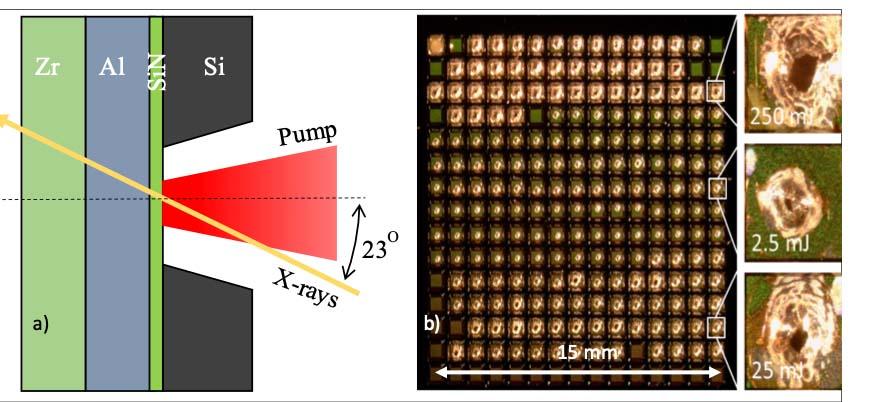
Laser-driven shock compression experiments with XRD at the Linac Coherent Light Source (LCLS): (a) schematic of experiment; (b) pump side of the sample after the experiments, with close-ups of sample sites where shots were taken at three different pump energies.
By placing a shock-compressed sample of zirconium under ultrafast time-resolved X-rays, Lawrence Livermore National Laboratory (LLNL) scientists and collaborators were able to see an intermediate phase along the transition between two solid phases.
Theory has predicted the existence of an intermediate step in this phase transition, but it had not been observed until now.
"Knowledge of the atomic-scale phase transition mechanics will significantly contribute to the accuracy of molecular dynamics models of material transformations," said LLNL materials scientist Mike Armstrong, lead author of a paper appearing in the journal JOM.
These experiments were performed with ultrafast time resolution, which allowed the team to see the finest details of how the material changes under shock compression and obtain a tremendous amount of information in a single experimental campaign. The experiments were performed at the Linac Coherent Light Source (LCLS), using the Materials in Extreme Conditions (MEC) end station.
The mechanisms of phase transitions in bulk materials play a similar role to the transition state in the study of chemical reactions. Detailed knowledge of these mechanisms -- and the ability to control them -- has the potential to revolutionize applications such as material synthesis.
By focusing in detail on the very short (sub-nanosecond) times before and during the transition, the team found that the mechanism of transformation occurs through a body-centered cubic non-equilibrium intermediate state, in contrast to prior experimental findings at longer (diamond anvil cell and gas-gun) timescales.
"Developing the tools and approaches to take advantage of the 100 picosecond laser drive at the MEC for these measurements allowed us to highlight the importance of time-dependence and kinetics in understanding the behavior of matter at extreme conditions," said LLNL physicist Harry Radousky, a co-author of the paper.
The team took close to 700 shots in a couple of days.
"When this method is mature, we expect to be able to efficiently obtain comprehensive information about material transformation kinetics at the scale of molecular dynamic simulations, which is a significant expansion of our knowledge of the fundamental behavior of dynamically compressed materials," Armstrong said.
Other Livermore researchers include Ryan Austin, Elissaios Stavrou, Jonathan Crowhurst, Paulius Grivickas, Tian Li, Joseph McKeown, Art Nelson, John Roehling, Nick Teslich and Jon Belof. The work was funded by LLNL's Laboratory Research and Development program.






